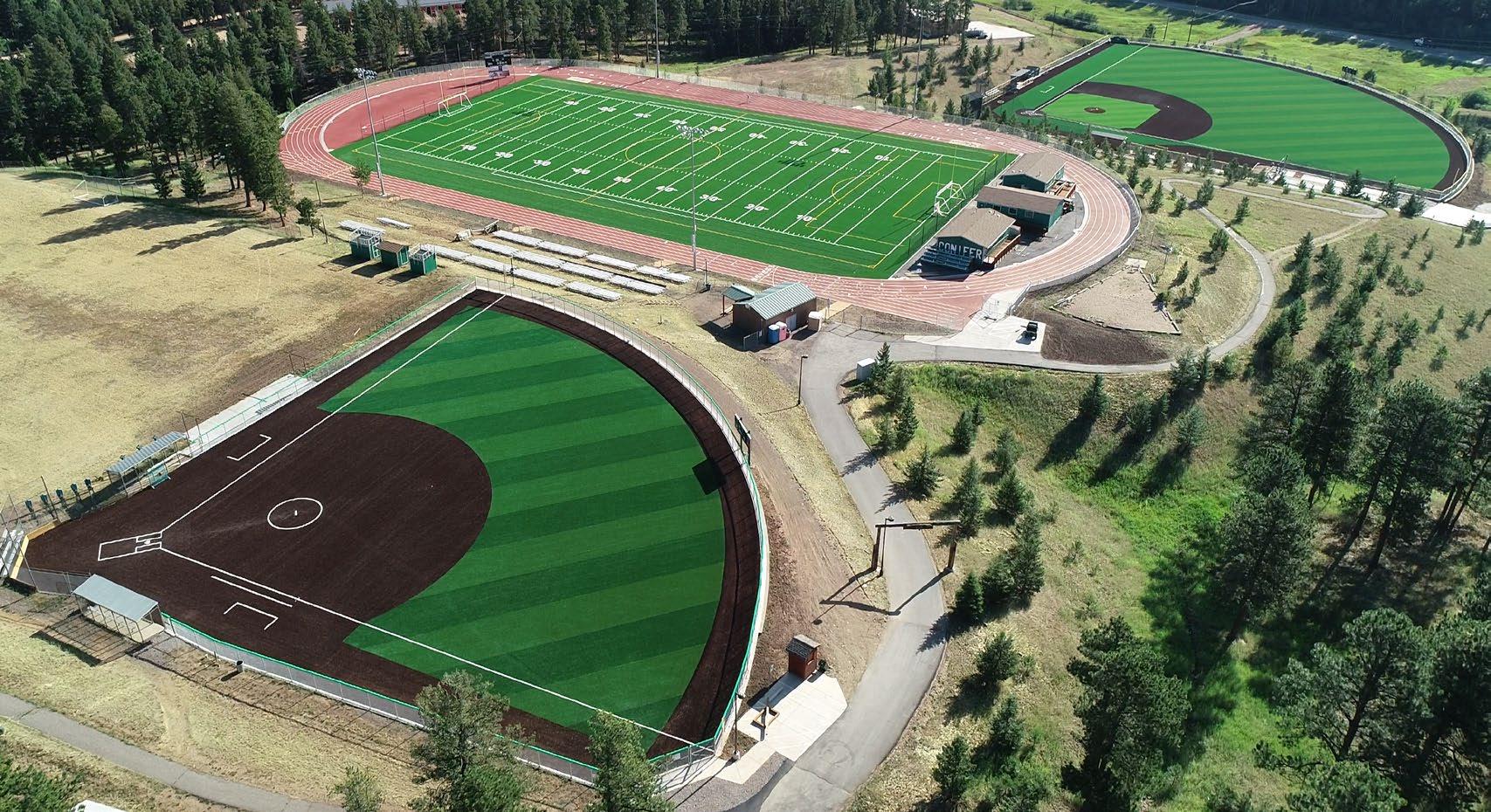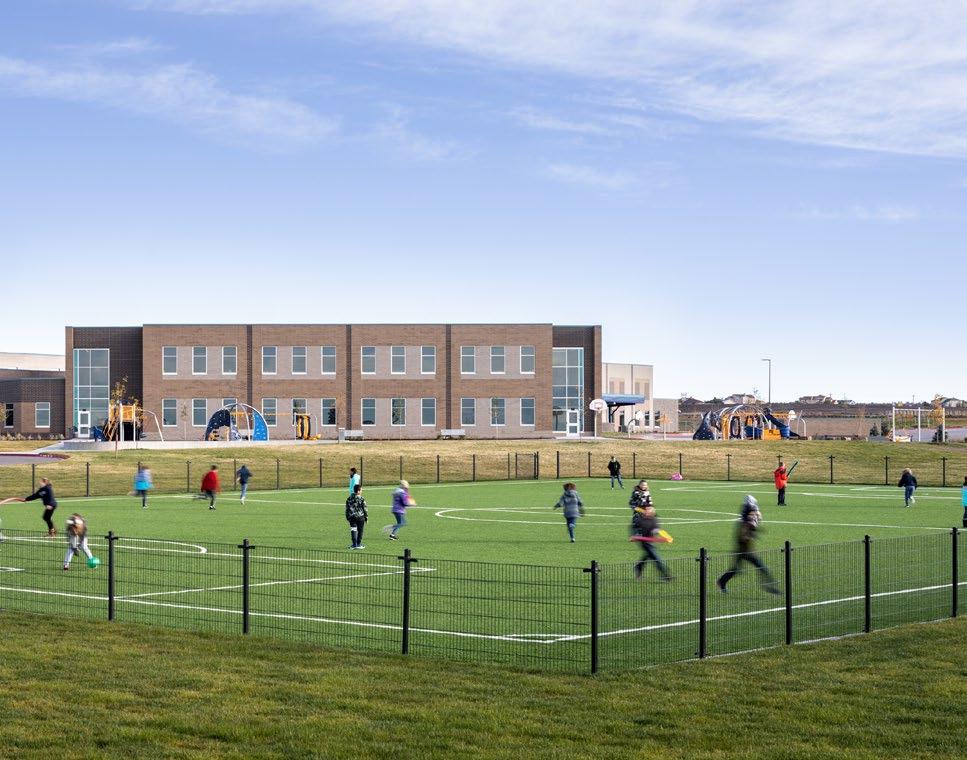
6 minute read
Synthetic Turf: Growth & Lifecycle Considerations
By Robyn Bartling, PLA, ASLA, Principal and Craig Stoffel, Associate, Hord Coplan Macht
Synthetic turf has become an increasingly popular option for municipalities, park and recreation districts, educational campuses, and others responsible for maintaining fields and recreation areas. The global synthetic turf market is expected to grow by USD 1.49 billion during 2020-2024, according to Technavio. Turf has risen in popularity for a variety of motivations – from advances in technology to ecological benefits, maintenance, and budgetary considerations – and is likely to see continued growth with a variety of lifecycle considerations. Reviewing and discussing key questions can help determine the type of solution to implement. We recommend several factors when considering synthetic turf versus natural turf. 1. What are the proposed uses? 2. How many programmable hours will the fields be in use annually? 3. What is the availability and budget for irrigation water now and in the future? If synthetic turf is selected as the best option, we work to educate our clients on the key differences and benefits as it relates to the different types of systems,


Growth + Lifecycle Considerations
maintenance and long-term planning and sustainability goals.
Ecological Benefits
The most significant ecological benefit of synthetic turf is the reduction in water use. Other benefits include reduced pesticide/weed control products and lower emissions with no mowing. The synthetic turf materials are advancing as well to be more ecologically viable. There are now options for infill that can be repurposed as soil amendment at the end of its useful life as well as shock pads with “cradle to cradle” (C2C) certification, which are products that are assessed for environmental and social performance. Site Preparation
Site preparation varies depending on soil conditions and if the field is installed on an undeveloped site or is a conversion from natural turf. In Colorado, and especially along the Front Range, much of our soil has high levels of clay, which can cause expansion within the soil. Compaction and drainage strategies often need to be


PLANNING + LANDSCAPE ARCHITECTURE
1800 Wazee St Ste 450, Denver, CO 80202 303-607-0977 | ww.hcm2.com

implemented to achieve proper installation and should be considered with the overall site plan.
Drainage
Drainage for fields can be complex depending on current detention and water quality requirements for the site, which are very site specific. On undeveloped sites, construction site disturbances will be incorporated into the overall site design and drainage plan. For turf field conversions it is important to evaluate the entire site to determine if current water quality and detention requirements are being met. With site disturbance we often

need to include improvements or additions to the water quality and detention to meet current requirements. This could mean site and cost impacts well beyond the field area to provide new or enlarged water quality and detention facilities.
Maintenance
Synthetic turf installation eliminates the need for irrigation and greatly reduces overall maintenance requirements from no mowing to no need for replacement/ reseeding or sodding of natural turf areas.
Costs
While there are both short-term and long-term cost savings associated with a synthetic turf system, there is also a large upfront investment. It is important to weigh the proposed uses and lifecycle implications against the budget needs of the project when selecting this type of system.
The outlook for synthetic turf is strong from an ecological and maintenance standpoint, as well as other factors including safety, durability and increased programming for more playable hours. There continues to be significant demand for high-quality playing and recreation surfaces with more options and technology advancements on the horizon.
LEADERS IN PARKS & RECREATION
TURF


TRACK

TENNIS
LOCAL & EXPERIENCED
Based in Denver, CO, our local experts can offer a full-service package and lead the construction, surfacing and maintenance of your facility. One company, one solution.
FINANCIALLY STABLE
Part of Tarkett Sports, a division of the Tarkett Group, a worldwide leader of innovative flooring and sports surface solutions, we have unprecedented financial support and stability. You can rest easy.
LEADING DURABILITY
Manufactured and installed with the highest attention to detail, our systems showcase proven durability.
COLORADO PARKS & RECREATION ASSOCIATION
PO BOX 1037 Wheat Ridge, CO 80034
Reach Colorado park and recreation leaders, decision-makers, and buyers!

MAGAZINE FAST FACTS: 6,000 magazines printed annually
20% CPRA Industry Partner members receive up to 20% off advertising
NEW ad rates for 2021 – as low as $375
Multi-Department reach:
PARKS & PLAYGROUNDS
Park supervisors • Development managers Park board members • Groundskeepers
YOUTH & ADULT RECREATION
Recreation directors and coordinators Athletics coordinators • Group leaders Aquatics managers • Event planners Therapeutic recreation coordinators Senior Center managers • Trip organizers
FACILITIES
Facility managers • Rink/arena managers Aquatic/water park directors • Rental staff
GOLF COURSES
Course managers • League coordinators Facility rental staff • Event planners Golf instructors
NATURE CENTERS
Nature center managers • Exhibit curators Environmental educators • Naturalists CPRA is a dynamic, proactive organization that creates healthy residents and livable communities by promoting excellence in parks and recreation.
Colorado Byline is a hyper-targeted magazine mailed to more than 1,300 CPRA members and
affiliates. Published four times per year, the publication provides educational content focusing on current issues and industry trends. By advertising in Colorado Byline, you’ll have the perfect opportunity to market directly to these highly influential professionals who need and rely on your products, services, and educational opportunities.
OFFICIAL PUBLICATION OF COLORADO PARKS & RECREATION ASSOCIATION
cpra-web.org | Spring 2020
Stay wild. Stay safe. GENERATION WILD IS BACK WITH HOPEFUL MESSAGES FOR KIDS AND FAMILIES
+• FOR THE SAKE OF GEN Z: SHAPING THE FUTURE OF HEALTH • 2019 CPRA ANNUAL REPORT • FINDING STRENGTH THROUGH ADVERSITY • A CALL FOR COMMUNITY • STAY WILD. STAY SAFE. • CAN A GRANT HELP YOUR PROGRAMS? • WORTH THE WAIT: LESSONS FOR NAVIGATING BARRIERS
Advertising Deadlines & Special Sections*
Winter 2021 magazine issue
Ad deadline: January 30, 2021 | Mails: March 2021
Special sections: Aquatics and waterparks; sport and fitness facilities; Park & Recreation education
Spring 2021 magazine issue
Ad deadline: April 5, 2021 | Mails: May 2021
Special sections: CPRA member awards; fields, turf and golf courses
Summer 2021 magazine issue
Ad deadline: July 8, 2021 | Mails: August 2021
Special sections: CPRA Annual Conference information; Engineering, design, and construction
2022 Commercial Buyer’s Guide (Mailed with Summer Issue)
Ad deadline: July 8, 2021 | Mails: August 2021
Fall 2021 magazine issue
Ad deadline: September 27, 2021 | Mails: November 2021
Special sections: Product innovations and product design; ADA certified
*Editorial content subject to change










